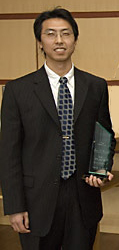Wei He
The EurekaAlert! article Purdue researchers develop technology to detect cancer by scanning surface veins said
A new technology for cancer detection that eliminates the need for drawing blood has been developed by Purdue University researchers.
Researchers from Purdue’s Cancer Center, Department of Chemistry and Weldon School of Biomedical Engineering collaborated with cancer and biotechnology experts from the Mayo Clinic to develop technology to detect tumor cells within the human body. By shining a laser on surface veins, such as those on the wrist and inside the cheek, researchers are able to reveal and count circulating tumor cells.
The technique could provide doctors and patients results in a matter of minutes and save the medical industry millions of dollars in testing equipment, said Wei He, a graduate student in the Department of Chemistry and the Department of Biomedical Engineering. He worked on the project with Low and Cheng.
By directly labeling tumor cells while they are in the bloodstream, some of the costs and problems associated with testing drawn blood samples can be avoided, He said.
“One sample can require five to 10 test tubes during the course of sampling, processing and analysis such as handling, labeling and washing,” He said. “In addition, large hospitals can have more than 300 cancer patients in one day. Such a large influx can cause delays in sample processing and delays can affect the results of analysis.”
Wei He is a Ph.D. Candidate concentrating on Analytical Chemistry &
Biomedical Optics at Purdue University.
Wei developed a semi-automated and standard platform for in vivo,
non-invasive, quantitative, and real-time detection of rare circulating
tumor cells in circulation. This imaging technique, “in vivo flow
cytometry”, can be used for diagnosis of cancer at early stage, the
monitoring of minimal residual disease after removal of malignant
masses, and evaluation of chemotherapy. He also developed an in vitro
screening test for diagnosis of ovarian
cancer
and evaluation of chemotherapy.
Wei coauthored
In vitro and in vivo two-photon luminescence imaging of single gold
nanorods.
He was awarded provisional patent 3220–79162 for an
in vivo flow cytometry method and device.
He was
featured in
BusinessWeek’s Academia’s Brightest Tech Stars & Tech’s Best Young
Entrepreneurs in 2006 and won the
Purdue University’s Burton D. Morgan Center for Entrepreneurship
Prize in
2006.
Wei earned his Bachelor of Science in Life Sciences at the
University of Science & Technology of China, Hefei, China in
2002.
Read
Purdue’s Gold Nanorods Brighten Future For Medical Imaging.





